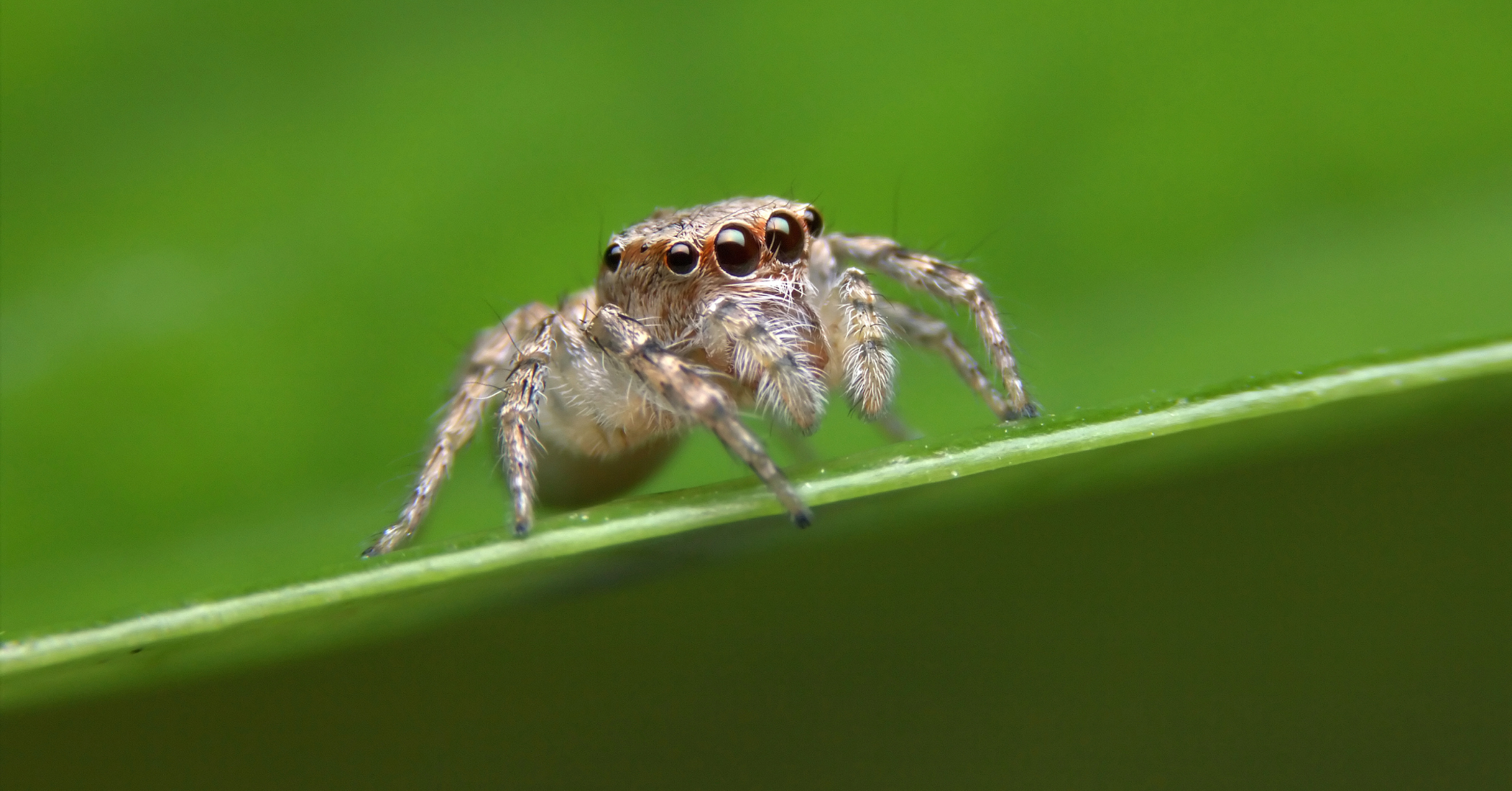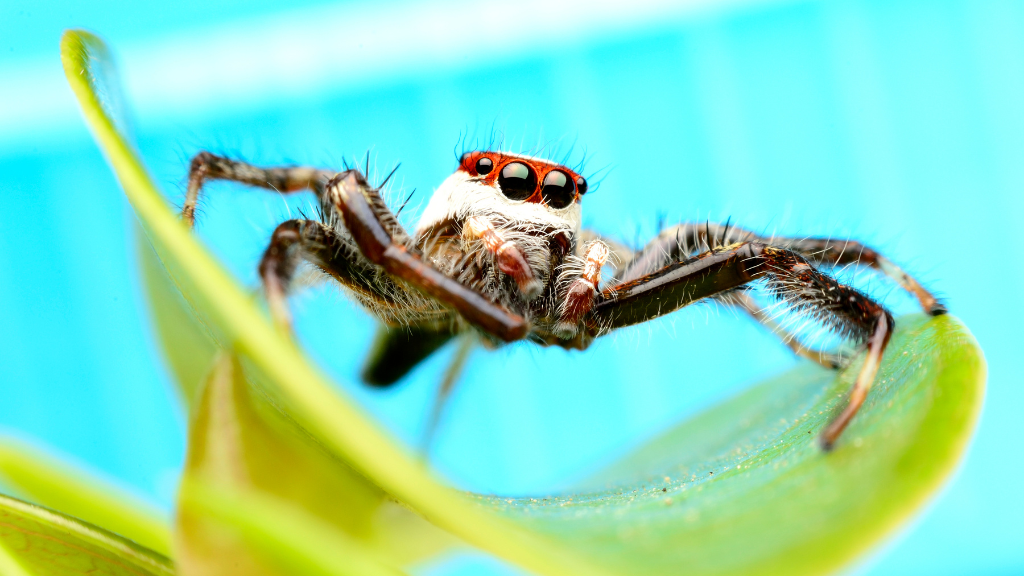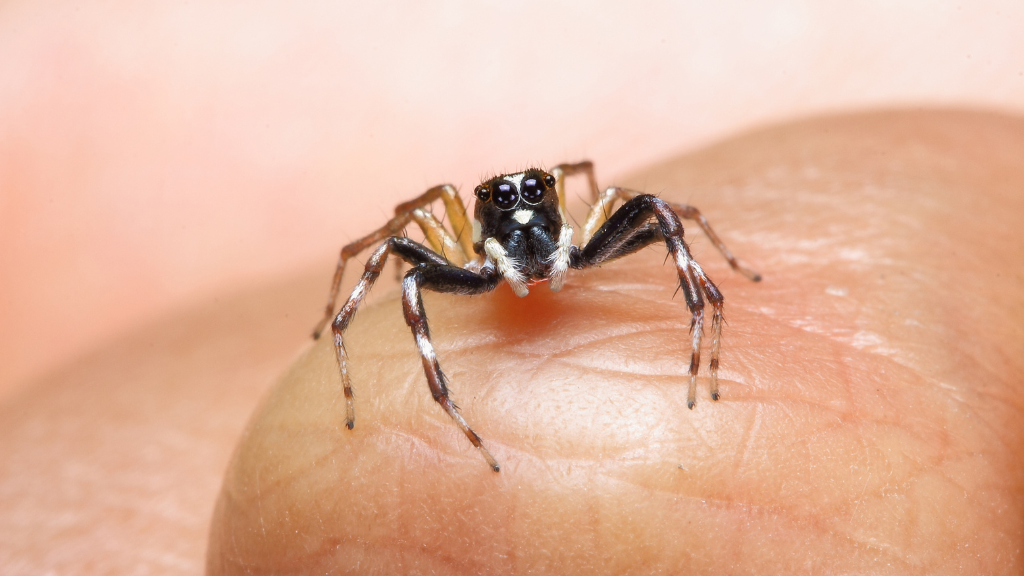Are Jumping Spiders Poisonous?

Did you know jumping spiders make up the largest family of spiders? With over 6,000 identified species, there’s a good chance one of these arachnids has made its way into your home or garden before.
Like most spiders, jumping spiders aren’t known to bite humans unless they’re mishandled—but if you’re one of the unlucky ones, these bites sting. Learn how to identify jumping spiders, what their behaviors are, and what to do if one happens to bite you.

WHAT ARE JUMPING SPIDERS?
Jumping spiders are from the family Salticidae and are best known for their ability to jump great distances. They can jump up to 30 times their body length—or farther—depending on the species. These spiders are active daytime hunters, so they’re always on the move and don’t build a web to wait for prey.
The most common jumping spider species found indoors is the Phidippus audax, also known as the bold jumper spider. This species can reach up to 19 mm in length, making them one of the larger species in the Salticidae family.
The Habronattus genus of jumping spider is also very common in the United States and is known for its colorful males. The jumping spiders of this genus are sometimes referred to as paradise spiders or bird of paradise spiders because of their unique displays.
APPEARANCE
Jumping spiders are typically small (usually 5–10 mm) and easily identified by two prominent eyes on the front of their face, with three other smaller pairs of eyes along the side or top of the head. Jumping spider heads are more rectangular in shape than other spider families, and their bodies are covered in hair. Jumping spiders also have distinct chelicerae—pincer-like mouthpart appendages—that they move around to aid them in grooming, mating, and hunting, almost like a fifth set of legs.
Male jumping spiders can have a range of colors including black, white, green, blue, orange, and red, and they use these colorful displays in choreographed mating rituals. They also commonly have metallic blue or green chelicerae. Female jumping spiders are more monochromatic and are often gray in color. They tend to be larger than males.
HABITAT
Many jumping spider species live in tropical forests, but they can also be found in the desert, like the Phidippus californicus species. Because Salticidae is such a large family, different species of these spiders can be found pretty much everywhere in the world except for Antarctica.
Indoors, you might see jumping spiders around windowsills or door frames, where other insects (i.e. their prey) are more likely to enter homes. Jumping spiders are active during the day and dormant at night.
You won’t find these spiders resting suspended on a web (like many house spiders), but you may discover their silky web retreats around your home. These web retreats are used for molting, laying eggs (suspended in a silk sac), and seclusion at night. You might find web retreats in wall corners, under furniture, or outside between leaves and bark.
DIET
Because jumping spiders are active hunters, they don’t use webs to catch prey or wrap up prey for later. Instead, they attack and feast on one meal at a time.
Jumping spiders are mainly carnivorous and eat insects. Because they’re so adept at leaping onto prey, their diet varies widely and includes other spiders as well. Female jumping spiders in particular can be very cannibalistic—often eating males after mating with them or eating males that have failed to impress them in the mating ritual.
Jumping spiders also use their large chelicerae to help them subdue and feed on large prey like crickets, praying mantises, and flies. In some regions, these spiders are nicknamed “fly tigers” because of their preference for flies and their ability to pounce on them like a cat.
VISION
Jumping spiders are known for having amazing vision—better than any other spider family—because they rely on their eyesight to stalk and catch prey. Habronattus spp., for example, can see colors on a spectrum from UV to red and often choose red-colored mates and prey.

WHY ARE THEY CALLED JUMPING SPIDERS?
Jumping spiders earned their name because they leap great distances to move and stalk prey. Unlike other jumping insects that rely on large, muscular back legs, jumping spiders have a hydraulic system that propels them forward. When jumping spiders jump, they also anchor themselves with a silk trail.
When they’re not jumping, these spiders are actually pretty slow movers.

WHAT HAPPENS IF A JUMPING SPIDER BITES YOU?
Jumping spiders have been known to bite humans if they are being crushed, mishandled, or threatened. These bites can be painful and leave welting and redness similar to a mosquito bite.
If you’ve been bitten by a jumping spider, be sure to wash the area with soap and water, and apply a cold compress to help with the pain and possible swelling. If you have worsening symptoms, or if you have an allergic reaction, talk to your doctor right away. Watch for wheezing or swelling of the face, throat, tongue, etc., as these are all signs of anaphylaxis (a severe allergic reaction).

ARE JUMPING SPIDERS POISONOUS?
Jumping spiders do use venom to subdue their prey. However, this venom is not likely to cause a serious medical reaction in humans or pets. If your cat or dog ingests a jumping spider, watch your pet for signs of allergic reaction and contact your veterinarian if they show any adverse symptoms.
If you’ve encountered jumping spiders in your home, contact Moxie Pest Control today. Our friendly experts take the time to protect your home with professional-grade products that are both pet and family friendly. Our barrier treatments keep pests away and help you maintain your peace of mind year-round.
SOURCES
- https://uwm.edu/field-station/a-jumping-spiders-story/
- https://australian.museum/learn/animals/spiders/fringed-jumping-spider/
- https://georgiabiodiversity.org/natels/profile?es_id=35238
- https://www.fs.usda.gov/Internet/FSE_DOCUMENTS/fseprd1057184.pdf
- https://entnemdept.ufl.edu/creatures/misc/regal_jumping_spider.htm
- https://www.webmd.com/a-to-z-guides/what-to-know-about-jumping-spiders
- https://extension.psu.edu/bold-jumper-spider
- https://entnemdept.ufl.edu/creatures/misc/jumping_spiders.htm
- https://www.pestworld.org/pest-guide/spiders/jumping-spiders/
- https://entnemdept.ufl.edu/creatures/MISC/Habronattus_jumping_spiders.htm
- https://www.livescience.com/jumping-spiders
AUTHOR BIO
Courtney Enzor has worked in the pest control industry for about a decade. From helping you build a fly trap to giving you the best tips for identifying various bugs, she loves answering all your pest-related questions and sharing her pest-related expertise through writing. At the end of the day, she hopes her content will help people avoid mishaps and keep families happy and healthy!

